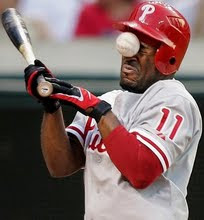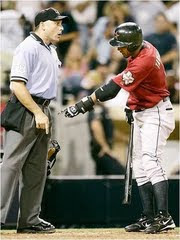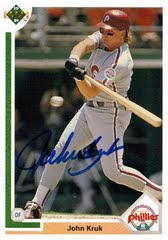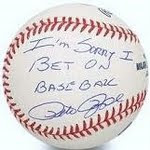Tigers:
- SP Max Scherzer
- RP Daniel Schlereth
- RP Phil Coke
- CF Austin Jackson
- CF Curtis Granderson
- SP Edwin Jackson
- SP Ian Kennedy
The Tigers
The Tigers by far got the best end of this deal. Seeking to shed payroll, fill in some bullpen holes, and acquire cheap, young talent, the Tigers traded away one of the games best value players (Granderson) who plays a mean CF in terms of both offense and defense, in addition to a soon-to-be 27 year old hard-throwing right-handed SP (Jackson) who over-performed last year and generally has below average, but improving control, no strikeout talent and two years left until he reaches free agency. In exchange, the Tigers received four quality players and met each of their goals. The prize of the Tigers' acquisition was Max Scherzer, a soon-to-be 26 year old, hard-throwing right-handed SP (Scherzer) with high strikeout talent, above-average control and three, possibly four, more years of team control before he becomes arbitration eligible. If Scherzer does not qualify for super-two status next offseason, the Tigers will end up paying a better-than-Jackson SP less than $1 million, while Jackson probably makes at least $10 million over that same time frame. In addition to Scherzer, the Tigers also acquired two relievers: Phil Coke, a solid and above average RP who limited the walks and struck out more batters than the league average while playing in the AL East last year, from the Yankees and Daniel Schlereth, a closer-of-the-future kind of RP with great stuff and questionable control, from the Diamondbacks. Considering that Lyons and Rodney are free agents, this gives the team more leverage when dealing with Brandon Lyon and a viable set of cheap, late-inning relievers for the Tigers. The Tigers also got Austin Jackson, one of the Yankee's top prospects, who profiles as a league-average (or better) hitting CF with great speed and range to replace Granderson. At just 22 years old, Jackson has a lot of upside and 6 years of major league control left to his name.
Conclusion: The Tigers accomplished everyone of their team's goals with this trade. They shed payroll, replaced semi-expensive players with cheap replacements, filled bullpen holes and upgraded their starting rotation.
The Yankees
The Yankees also made out big with this trade. With Johnny Damon departing to free agency and 4th OFs Melky Cabrera/Brett Gardner and not-quite-ready CF prospect Austin Jackson left to fill both center and left fields, the Yankees were in search of one, if not two, outfielders. Although you can never discount the Yankees getting involved in the Matt Holliday/Jason Bay sweepstakes, this helps the team fill up centerfield at a great value and it gives the team a lot more negotiating leverage against Scott Boras and his clients (Damon, Holliday). Granderson is without a doubt an all around upgrade over the aging and expensive Damon and if the Yankees can clobber everyone on their way to a world series title with Damon in left and Cabrera/Gardner, I see no reason why they can't do it with Granderson in center and Cabrera/Gardner in left. With Granderson, the Yankees acquired a not-cheap, but not-expensive player with some of the best all around tools in the game (walks, hits for power, quality range, average arm) and probably have plenty of money left over -- especially if they let Damon walk -- to make another big free agency splash while keeping the payroll under the 2008 mark. And what did it cost them? None of their core young talent (Phil Hughes, Joba Chamberlain, Mike Dunn, or Jesus Montero). Just a slightly above average, but still useful reliever (Phil Coke) and a starting pitcher with no room on the roster and more hype than true talent (Ian Kennedy, aka "the next Greg Maddux").
Conclusion: The Yankees got what they needed -- a quality outfielder and leverage in the free agency market -- at a great value in terms of both $ cost and players traded, so they are sure to be great for online betting.
The Diamondbacks
Oh boy, where to begin. The Diamondbacks got ripped off. They traded away a young, cheap ace pitcher and high talent potential closer of the future and bought high on a hard-throwing (but improving) SP (Jackson) who over-performed last season and has at least two less years of team control to his name in addition to a brand name minor leaguer with limited "success" at any level of play since 2007. For a guy who is supposed to be "the next Greg Maddux, he needs to start limiting the walks (his career major-league equivalent BB/9 is 3.95). Kennedy is still relatively young (soon-to-be 26) and has been getting better at the strikeouts in AAA, but he's entering his "prime years" and has yet to show any significant major league success.
Conclusion: Kennedy may provide the Diamondbacks with a quality arm, but the risk inherent in him putting it all together (in addition to the probable regression from Jackson, a pitcher who outperformed his peripherals last year and also has a four year trend of increasing FB tendencies) makes trading away a cheap stud like Scherzer and high ceiling reliever like Schlereth an unwise gamble.
____
All in all, it's not like anyone expected the Diamondbacks to contend in 2010 anyways. Perhaps the team, realizing this, decided to take the long-term risk with Kennedy (who the Yankees had no room for), while gaining another arm (Jackson), who, in addition to Webb, the team can unload for some quality prospects to a contender come July. The Tigers and Yankees won big on this deal and the Diamondbacks took on a whole lot of unnecessary risk (and some salary), to which I call them the unequivocal losers of the deal.







5 comments:
Despite the fact that a rotation of Haren-Webb-Jackson-Kennedy+other guy would be pretty solid, the arizone pen is pretty thin and the offense is nothing short of terrible.
They have a very good rotation and one that should be for years to come with some young guys. There rotation is weak, but there offense is the problem. They have some very good young power hitters that need to learn more of a complete game.
I'll find TBO's post somewhere but there's a reason team's bullpens aren't consistent year to year. You can rarely rely on bullpen guys, guys have limited stuff anyways which means who cares if you think a bullpen is thin right now. You can always find guys in your farm system or pick up someone cheap in FA or from another team.
I don't care to actively seek bullpen guys in trade which means I could care less that Tigers got Coke and Schlereth. Unless the Tigers got Joe Nathan, I could care less what bullpen guys they received and just because the D-Bags, er D-Backs doen't have a joe nathan guy doesn't mean there bullpen will be thin. Because of the unpredictability of bullpen guys- you can not say with certainty how good Arizona's bullpen will be next year
Tbo did no actual math to determine correlation and there is actually so much inconsistency due to annual bullpen turn over. Outside of Juan Gutierrez, there is no one who can pitch in that bullpen
There is Justin Upton, Mark Reynolds and then a bunch of nobody hitters. When Steven Drew and Conor Jackson make up the core of "the rest of the offense", you know you have issues. Obviously the addition of Kelly Johnson since I wrote this post is a favorable one for the Dbacks, but its not the necessary infusion of offense the team needs to compete in the NL West in 2010. For the NL's most HR happy park, you'd really expect a better offensive core.
Regarding bullpens, the volatility has to do with sample sizes. 60 IP is nothing from which to gauge true talent year-to-year. This is why a reliever's in-season FIP is somewhat pointless. 3-year evaluations are needed, in my opinion, under the 60-40-20 weight rule
Post a Comment